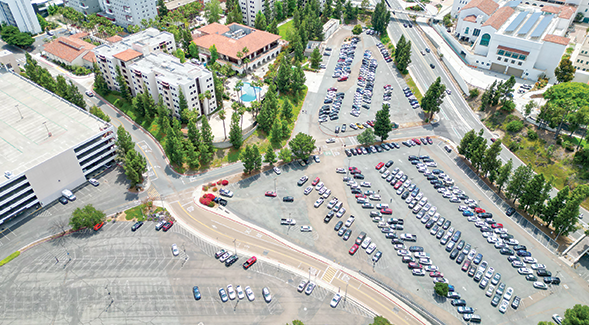Guidance for Returning to SDSU Campus
Following the pivot to virtual instruction and telework on Aug. 21, faculty, staff and students are returning to campus on Aug. 22. Here is some guidance.

San Diego State University faculty, staff and students are returning to campus on Tues., Aug. 22, following Tropical Storm Hilary. University leadership and the emergency planning and response team are encouraging a number of actions while returning to campus throughout this week.
Immediately Report Incidents
Student residents, faculty and staff are likely to see some water-related impacts as they return to campus. A number of residence halls and campus buildings experienced water intrusions and crews have been on the ground addressing these issues.
If you observe any issues, please report them right away. This will allow SDSU teams to quickly assess and address storm-related impacts. Faculty, staff and students at SDSU and SDSU Imperial Valley should immediately report urgent facilities-related issues to Facilities Services Work Control at 619-594-4754; for non-emergency facilities issues, fill out the online Work Control form.
For student residents, as previously shared, submit any issues via a service request on the Housing Portal, and report that information to your community front desk.
Parking and Transportation
Use caution when coming back to campus, as San Diego and Imperial County officials are still addressing flooding, downed trees and debris on roads and highways in some areas. Also, parts of the university did flood on Monday, and several buildings have reported water intrusion. Be attentive to signage restricting access to certain areas of campus.
Instruction and Research
As the university moves back to in-person instruction on Tuesday, Aug. 22, faculty are encouraged to continue communicating with students about course plans with students via Canvas Learning Management System (LMS). Also, students should log in to review their course materials in Canvas.
As the university has shared, the storm may have impacted members of the community differently, especially given the reports of power outages in both San Diego and Imperial Valley, and both patience and understanding are encouraged at this time.
Researchers are encouraged to communicate directly with project personnel about resuming in-person activities.
Technology Support, In-Class Instruction
Instructional Technology Services (ITS) remains available to support faculty with their understanding and implementation of technologies for teaching, including the Canvas LMS. For more information, visit the ITS Support page. Faculty and staff seeking live online support can also drop-in to the virtual Faculty Instructional Technology (FIT) Center.
Support Services Ongoing
SDSU continues to offer students, faculty and staff a range of support services, including counseling, emergency financial assistance for students and virtual support. You can find a list of available resources online.
Update Information, Download SDSU Safe App
The university encourages all students, faculty and staff to download and use the free SDSU Safe app (for Apple and Android) and to make sure your contact information is up to date with the university. This will allow you to more quickly receive text messages and mobile app push notifications in the event of campus emergencies at SDSU and SDSU Imperial Valley.
An important note: You will receive emergency text notifications only if your cellphone is on file with SDSU, and you must opt-in to receive outreach messages.
Update Your Information
- Students: Ensure that your contact information, including mobile phone numbers and your current local address, is up to date with SDSU. Log into my.SDSU to update your cellphone number under the "Contact Details" link in the Profile tile. You can also update your local address under the "Addresses" link in the Profile tile. Lastly, be sure to update your emergency contacts under the "Emergency Contacts" link in the Profile tile. Students can also choose to opt-in to receive outreach messages that are not emergency or urgent in nature. To do so, students should select the opt-in box.
- Faculty and staff (except auxiliary employees; see details below): Make sure your mobile phone number is updated via PeopleSoft. Once logged in, click the drop down main menu, click "Self Service," then "Personal Information." You can update your contact information on the “Personal Summary Information” page by clicking “Change Phone Numbers.” From the drop-down menu, select “Mobile” and add your number in the “Telephone” field. Click “Save,” then the “OK” button before exiting.
- Auxiliary employees (SDSU Research Foundation, Aztec Shops and Associated Students employees) should use the online form to update their personal information, and also to provide consent to receive important outreach messages from SDSU.
- For faculty and staff: Make sure your cellphone number is listed in PeopleSoft. This helps to ensure that you receive emergency text alerts from the university.
Download the SDSU Safe App
After downloading the SDSU Safe App, and to receive push notifications from SDSU, you must:
- turn on push notifications from SDSU via the app and
- make sure you have notifications enabled for the app on your device and also within the app. In the app, click “About/Preferences,” then click “Notification Setting,” then make sure notifications are “Enabled.”
Also, the SDSU Safe app contains a range of useful information and tools for daily and timely needs. It includes campus maps, information about support services, and reporting tools for sharing information with the university about incidents both when and after they occur. In an emergency, however, always call or text 9-1-1.
Visit Urgent.sdsu.edu for more information.



